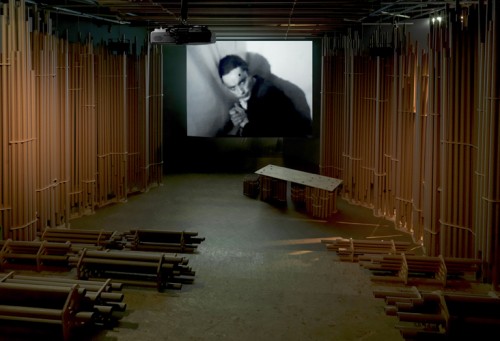
Tobias Putrih, "View of Siska International," 2010. Mixed media installation. Installation view at Espace 315, Centre Pompidou, Paris. Photo credit: Georges Meguerditchian. Courtesy the artist and Meulensteen Gallery, New York
“I don’t think art is about consistency. It’s about complexity … The key question for me is how to make an object that expresses its own self-doubt, questions its own existence.” — Tobias Putrih, in Tobias Putrih 99-07 (JRP/Ringier, 2007)
Tobias Putrih isn’t a filmmaker, but several of his site-specific installations have re-imaged cinema interiors through the creation of life-size environments, where actual films are projected for viewers to sit and watch. One of the things I respond to the most is Putrih’s usage of every day, ephemeral materials such as paper, cardboard, tape, twist ties, and plastic foam to create, among other things, usable structures. Putrih also uses these materials to create maquettes, many of them also cinemas, but the small-scale models often represent structures that would be impossible to construct or use.
Born in Kranj, Slovenia, Putrih represented his native country at the 52nd Venice Biennale in 2007. He now lives and works in New York and his fascination with process and the endless series of permutations that are possible when designing and constructing something is ongoing. Putrih recognizes that vision and experimentation are required to produce both functional structures and provisional objects, and has noted as much by saying:
“Blueprints, maquettes, models—these are all representational forms that describe the structure and proposed function of something. I’m interested in these forms as substitutes through which we can explore the potentials of an idea. It is much easier for me to justify the production of an object if I can insist that it is not a finished thing but rather just a proposal for an object or architectural space that will probably never be built… for me to float an idea in a provisional form that can easily be remade or disposed of makes sense, because such makeshift objects still beg questions about their own existence.” (in Tobias Putrih 99-07)

Tobias Putrih, "View of Siska International," 2010. Mixed media installation. Installation view at Espace 315, Centre Pompidou, Paris. Photo credit: Georges Meguerditchian. Courtesy the artist and Meulensteen Gallery, New York
In riffing off of works by artistic and architectural titans such as Robert Smithson and Buckminster Fuller, Putrih has also revealed that his influences and inspiration aren’t solely confined to the fine arts, and include physics, science fiction and anthropology.
I like how several of his works have a collaborative component to them, with viewers often invited to construct models of their own or inhabit built environments. And like several of the other speakers from VAP’s Spring series of lectures (Muñoz, Bartana) Putrih is fascinated by experimental utopias and this permeates his work; “art and design (are) manipulative but also potentially therapeutic and socially ameliorative practices” (in Tobias Putrih 99-07).

Tobias Putrih, "View of Siska International," 2010. Mixed media installation. Installation view at Espace 315, Centre Pompidou, Paris. Photo credit: Georges Meguerditchian. Courtesy the artist and Meulensteen Gallery, New York
I’m really looking forward to hearing Putrih articulate some of the tension between the functional and the imaginative in his work when VAP welcomes him to speak in person soon. Please join us if you’ll be in Chicago!




Pingback: Hunting and Gathering & the Art of Ideas « This is not a white picket fence.
Pingback: Tobias Putrih | Recommended
Pingback: Tobias Putrih | Database